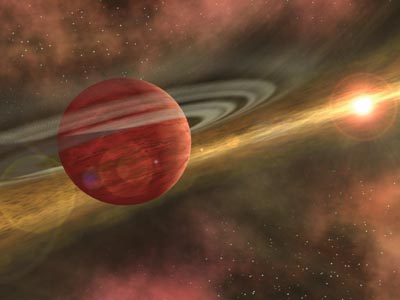Astronomy
Rochester Researchers Find ‘Baby Planet’
 |
| TAURUS BORN: William Forrest and Dan Watson, both
professors of physics and astronomy, have discovered evidence of what could
be the youngest planet ever detected—a world no more than a million
years old circling the distant star CoKu Tau 4 in the constellation Taurus,
420 light-years from Earth. Using data from the Spitzer Space Telescope,
which analyzes the infrared spectrum, the team found icy organic materials
sprinkled throughout several “planetary construction zones,”
or dusty planet-forming disks, around five young, sun-like stars. Shown
here in an artist’s conception, the planet cannot be seen directly,
but Spitzer’s infrared instruments clearly showed that an area of
dust in the disk around CoKu Tau 4 was missing, strongly suggesting the
presence of a planet. “We’ve seen the building blocks of habitable
planets, for the first time, unambiguously” in stars that will turn
out like our sun, says Watson. The team also detected icy dust grains in
the envelopes of several young stars, suggesting some of the important precursors
of life may be common components in the star-forming process. Originally
called the Space Infrared Telescope Facility (SIRTF), the critical infrared
“eyes” of the Spitzer telescope were designed in part by Judith
Pipher, professor emerita of physics and astronomy, Forrest, and Watson.
(Photo: NASA/JPL-CalTech/R Hurt (SSC-CalTech) |
|



